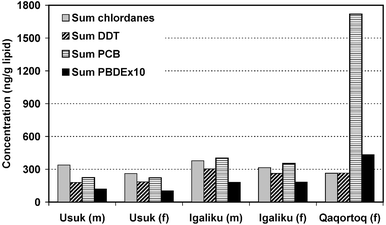Mussels and marine fish (shorthorn sculpin and Greenland cod) were sampled at three locations with varying human activity. Fish livers and mussels were analysed for polychlorinated biphenyls (PCBs), polybrominated diphenylethers (PBDEs) and chlorinated pesticides including chlordane and toxaphene. Levels of chlorinated contaminants in shorthorn sculpins from the background location, ΣPCB (217–224 ng g−1 lw), ΣDDT (180 ng g−1 lw) and hexachlorobenzene (32–44 ng g−1 lw), were in the same range as previously observed in eastern Greenland but exceeded the levels previously observed in southern and western Greenland. Multivariate analysis showed that pollutant concentrations were mainly explained by trophic levels of the species (cod > sculpins > mussels). A pooled sample of shorthorn sculpins from the harbour of Qaqortoq had significantly higher PCB and PBDE concentrations with a different congener pattern compared to the background site, while other contaminants were comparable. This points towards local pollution sources, possibly accumulated emissions from burning of waste.

You have access to this article
 Please wait while we load your content...
Something went wrong. Try again?
Please wait while we load your content...
Something went wrong. Try again?


 Please wait while we load your content...
Please wait while we load your content...